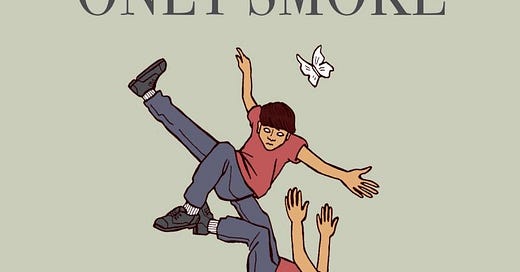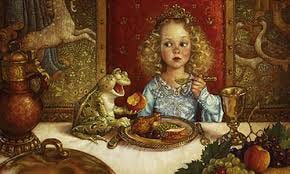Review: Only Smoke
Only Smoke, by Juan José Millás (Bellevue Literary Press, 2025), is a slim Spanish novel that explores big ideas about life and reading.
Only Smoke, by Juan José Millás (Bellevue Literary Press, 2025), is a slim Spanish novel that explores big ideas about life and reading.
Millás, who has written over twenty novels, is best known for his Young Adult books, and, in a passing way, there is something of a young-adult aesthetic evidenced in his latest offering in translation. It is a book pared down to symbols and signs.
Swift, smooth language clips out a story that is part bildungsroman and part cautionary tale. Indeed, the whole thing seems as flat as a myth. This is not an insult. It is a silhouette of a story the way Aesop’s fables are silhouettes. Every character is an outline and an argument. Every action is a means to an end.
In Only Smoke, a “troubled” father dies, and his estranged son inherits a mystery and, relative to his station, a small fortune that consists of an apartment, clothes that near-magically fit him, about a year’s worth of money, and a robust library.
After reading a notebook left abandoned by his father, Carlos begins to understand why his absentee father was deemed “troubled.”
In said notebook, the dead father has confessed to accidentally killing his daughter (Carlos’s half sister) when she turned into a butterfly that crawled out of her own ear.
Yes, she turned into a butterfly that crawled out of her own ear.
As a butterfly, she flew into the father’s study, where he caught her and pinned her to a board—the way you do–and, the next day, the human daughter was dead.
While investigating his father, Carlos begins to read one of his left-behind books: a copy of Grimm’s Fairy Tales. Carlos finds himself compelled to read these tales, and finds that the stories suck him in. Literally.
He becomes something of a Non-Playable Character in each tale and is pulled into each story, where he exists between worlds. In “Cinderella,” for instance, Carlos allows “himself to be carried along by the shifting narrative, which led him straight from one situation into another, as black holes are thought to do.”
Until “one night, as Cinderella was in the kitchen asleep on the bed of ashes that she had been assigned by her stepsisters, a telephone rang [and] he realized that it was ringing outside the fairy tale, on this side, the reality side, to which he returned momentarily. . . And he was surprised to find that scarcely a few minutes had passed, while inside the fairy tale it had been several years.”
When in the story he cannot affect a single thing. He has to watch as narratives unfold.
And he realizes, "this place I’m moving through now, my father also moved through it. My father, like me now, has been a ghost inside this story.”
The whole thing is an argument for how the books we read leak into our lives and somehow dictate our outcomes. Since this is the case, the tales we hear as, children or even young adults, have the greatest effect on our lives. We have been ghosts inside them since childhood.
As such, you can argue that stories written for children are more important than stories for adults. They are the foundation of society, and that was the point of the Brothers Grimm collecting them.
Let’s explore:
Perhaps, as a child, when you were first introduced to “Rapunzel” or “Snow White” or “Little Red Riding Hood,” you were fed an old wives’ tale that goes like this:
“The Brothers Grimm were not really writers. They just stole all their stories from a witch.”
According to legend, here is how that happened: in the village where the Brothers lived, there was a witch who was popular in the community for telling children—and only children—stories. She did not allow adults in her audience, so the Brothers disguised themselves as kids (however that worked), infiltrated story hour, memorized her tales, and reproduced them so that they might be shared amongst people of all ages.
It’s a good legend, but it is not quite correct.
True, the Brothers were story collectors rather than authors, but their stories came from several regions of what would become Germany—not just their hometown. And they had political reasons for collecting these works.
Philip Pullman, who put out a new translation of Grimm tales in 2012, argues the brothers were influenced by a professor who had the idea that “law grew naturally out of a language and a history of a people” and The Brothers Grimm were collecting stories—primarily from peasants—at “a time when scholars of law, of history, [and] language were examining and arguing what it meant to be German in the first place.”
They believed that the stories a culture tells its children are the beginnings of a belief system, and that a society’s behaviors can be traced to the actions of characters in stories they heard when young.
I like the argument. Let’s play around with the theory a bit.
Let’s take, for instance, “Hansel and Gretel.” In that tale, a brother and sister are captured by a witch who eats children. To rid themselves of the witch, they throw her in an oven.
Remember, “Hansel and Gretel” is a German story. It was first published in 1813.
Five generations later, the Nazis who grew up with these stories quite literally believed they were being held captive by a group of witches who ate children. So, they fired up the ovens.
It’s bleak and dark and fucking wild to suggest that the Holocaust happened the way it did because of “Hansel and Gretel” being a popular German children’s tale, but that is sort of the point of the Grimm’s work. And, honestly, a cultural action as insane as putting humans into ovens must be derived from something elemental, tribal, long-since absorbed, and, quite frankly, fantastical.
But let’s look more recently and let’s go in reverse.
Let’s take the critique of Baby Boomers: they are forever-children who focus on their own selfish interests.
But why?
Well, if you Google “What was the most popular children’s book for Baby Boomers?” you will see that it was Peter and Wendy (more popularly called Peter Pan).
In pop-psychology, a Peter Pan complex is a “term used to describe an adult who has difficulty growing up.”
They are all headed to the second star on the right, straight until morning.
To be fair, let’s not pick solely on the Baby Boomers.
As far as I can remember, the most popular children’s book for Gen X & the Oregon Trail Generation was The Giving Tree.
In that book, children are shown to be endlessly corruptive.
“If you have children,” the book seems to argue, “they will steal your fruit and chop off your branches for their own personal gain.”
Famously, my generation quit having kids.
More recently, Harry Potter (maybe the most popular children's book ever) is set in a world where your ancestry determines your worth—Muggles and Mudbloods are otherized—and every member of society belongs to one of two tribes—one is bad and the other is good and you have to choose which tribe you belong to. There are good people and Death Eaters, okay.
Alas, we are a repetitive species. We hear a story, we live that story.
In Only Smoke, Millás simplifies this phenomenon. He does not extrapolate to make conclusions about society or seek to justify the peculiarities of the modern human writ large.
Instead, he showcases a kind of personal repetition of obviously dangerous behaviors that, no matter how hard we try to avoid them, call us back as though our lives are predetermined tales—echoes of the books we have read.
While reading the Brothers Grimm, and while living in his father’s left-behind apartment, wearing his father’s left-behind clothes, and spending his father’s left-behind money, Carlos begins to live his father’s left-behind life.
When alive, Carlos’s father had an affair with his neighbor. This affair resulted in the birth of Carlos’s half sister, who died shortly after turning into the butterfly that crawled out of her own ear.
The neighbor—the deceased, half-sister’s mother—still lives next door, and Carlos and she start having sex. This sex results in a pregnancy. This pregnancy results in a new daughter.
And we are left to assume that the fates are already decided. That the new daughter will also die. But, of course, we do not know for sure. Perhaps all of these things are coincidences. Perhaps stories do not have to repeat themselves.
This complication and tension drives us toward a resolution: is Carlos doomed to be his father all over again? To kill his ear-butterfly daughter? Will Carlos also become “troubled”?
If there is a critique of Only Smoke, it is that the culmination of these mysteries do not blindside us, shock us, or send us reeling.
The book is a satisfying one, but the story ends as a Grimm’s Fairy Tale might—with a deus ex machina that results in a baffling resolution.
But here, I would suggest, is where Millás exemplifies a deep understanding of the work he is alluding to—the fairy tales the book was inspired by.
Often, these stories are misremembered. They end differently in the retelling.
For instance, at the end of “The Frog King, or Iron Henry” (The Princess and the Frog), no one kisses the frog. That’s not what happens. The princess tries to kill the frog. She has broken a promise to him, and he has annoyed her about it, and she wants him dead, so she throws him against a wall.
Then, he turns into a prince.
The next morning, a dude named Henry shows up and takes him on a carriage ride home. As they ride along, gold bands that Henry has had put around his heart so it won’t break, begin to break.
The story ends, and we never find out what that means.
I highly recommend reading both “The Frog king, or Iron Henry” and Only Smoke.







